
Date :2019-06-13
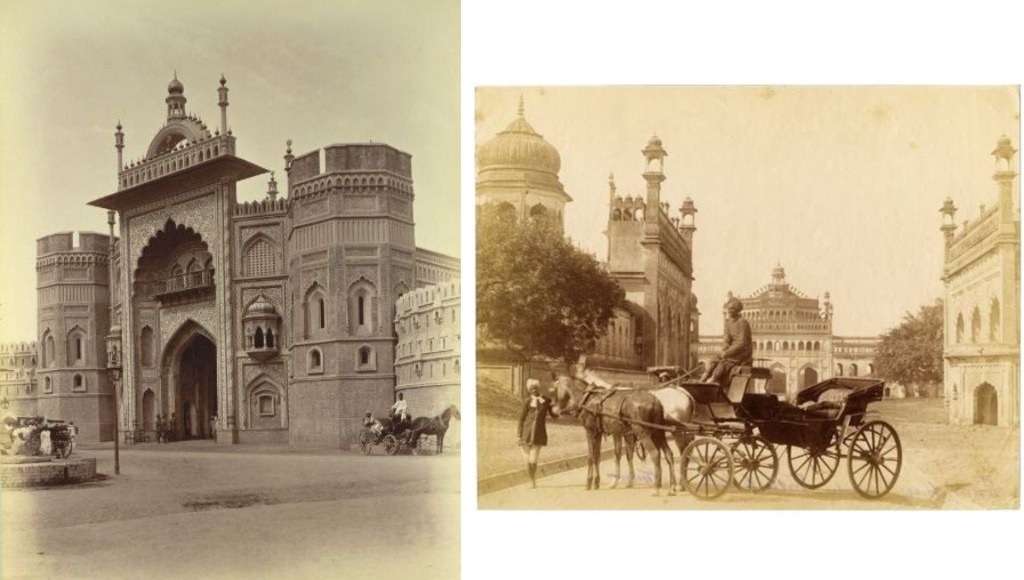
The artistic rivalry between the Nawab ruled Rohilkhand & Awadh provinces during the 18th & the 19th centuries, led to the creation of stylized gates & buildings including palaces, imambaras, mosques and centres of learning and administration in the respective capital cities of Rampur (above left) & Lucknow (above right). The decorative exteriors adorning the architecture of these two culturally similar cities have been the design inspiration for this collection.
Under the Rohilla Mohalla Project, designs representing prominent monuments from these two cities were carefully selected with the artisans and images with design details were given to the Rampur Zardozi master craftsman Iqbal Kamalzai. Being skilled in free hand drawing as well, Iqbal and his fellow artisans at his workshop (Kamalzai Zari) at first drew out on tracing paper the essential elements and nuances of the designs to be represented on the final product. The design was then transferred on net fabric, preparing it for Zardozi hand embroidery using glass beads or “cut-dana”. Since cut-dana is largely available in glossy colors, for this project, these colored beads purchased from the market were first dipped in acid to remove their sheen and give a matt finish in keeping with the aesthetics of the products in this design theme.
The following products were designed and manufactured entirely by hand at the Rohilla Mohalla Training Centre under the Rohilkhand-Awadh Design theme:
Training focus:
Date :2019-06-13
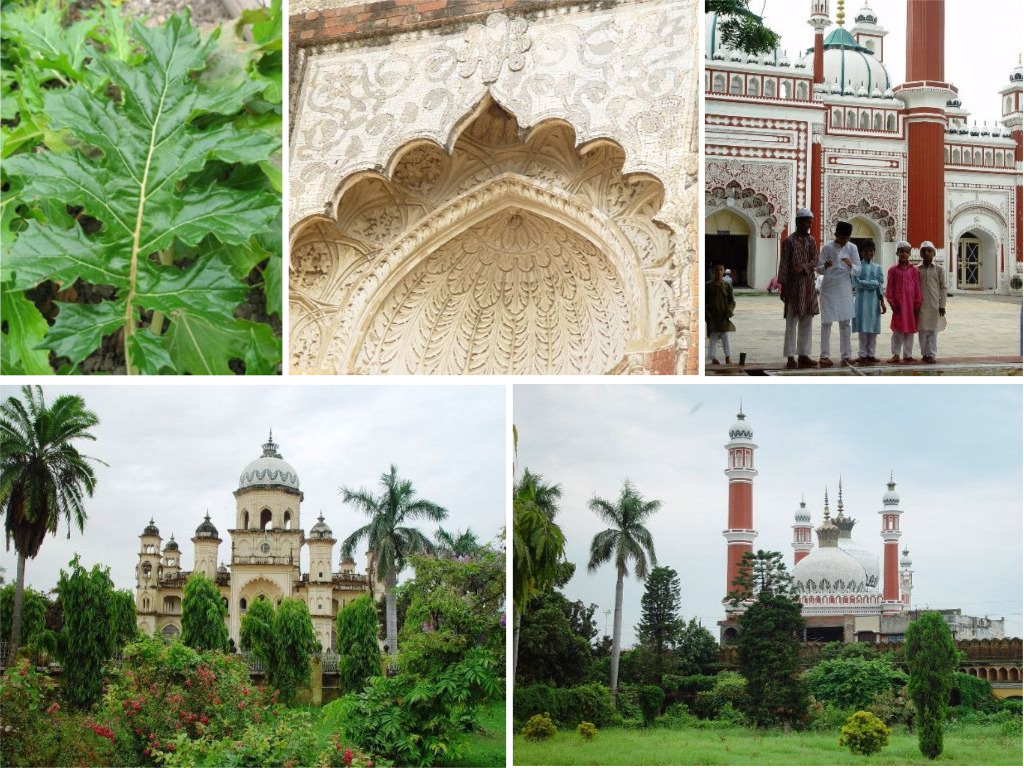
Under Nawab Hamid Ali Khan of Rampur (1896-1930), an extensive building program in the city was undertaken, which was executed by Chief Engineer W.C. Wright. Several of the buildings were built in the Indo-Saracenic style of architecture, synthesizing elements from the Islamic, Hindu and Victorian Gothic. Prominent among these is the Raza Library, with its treasure of old manuscripts, documents and rare books. This building was earlier the main palace known as “Hamid Manzil” and was later converted into a library to house the rare collection of the royal family. The Raza Library, Jama Masjid & Moti Masjid of Rampur, all have a design continuity in the “Acanthus Leaf” motif, which is showcased in this collection. This ornamental pattern (picture above), inspired by the deeply cut leaves of the Acanthus group of plants found in the Mediterranean, has been widely used in Greek, Roman, Byzantine & Gothic ornamentation.
Other patterns in this collection are inspired by the fading floral and geometric designs of the Hamid & Wright’s gates, which along with several other gates served as the many entrances to the walled city of Rampur. The gates of Rampur especially the Hamid and Wright gates were richly decorated with brick carving, an ancient craft found on the bricks of the Buddhist Stupas at sites spread across northern India, including within an hour’s drive from Rampur at Ahichhatra, the ancient capital of the northern Panchala Kingdom.
When the Rohilla Mohalla Project was initiated in 2012, these two gates stood crumbling but still prominent amidst the busy bazaar streets leading into the old town. There were very few old photographs of newly built Rampur and its architecture. Some are in the form of an album presented to Lord Curzon, Viceroy of India, by the Nawab in June 1905 to commemorate his visit to the city. Few other old photos are at the British Library under the Marquess of Reading Collection issued in 1911. However, none of them show the rich designs and the elaborate carving on the gates and other buildings clearly. At the start of the Rohilla Mohalla project, these designs especially on the top portion of these gates and buildings were photographed painstakingly, and from these photographs alone, the artisans drew out the “Khaaka” or the design on tracing paper, which was then transferred on the cloth being embroidered.
Date :2019-06-13
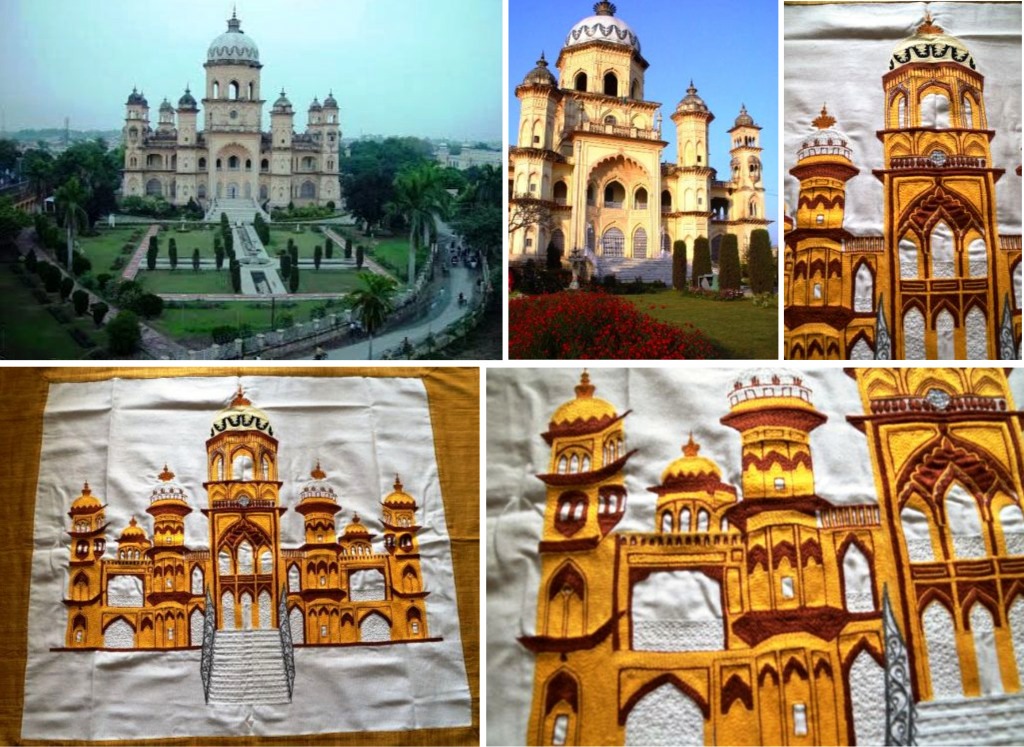
Rampur Zardozi master craftsman Mubashir Shaikh replicated with great detail and precision this iconic symbol of his city with rich Ari thread embroidery. The wall hanging took almost two weeks of continuous work to complete. The embroidery was done on cotton casement cloth and khaki colored raw silk fabric was added as the border.
Date :2019-06-13
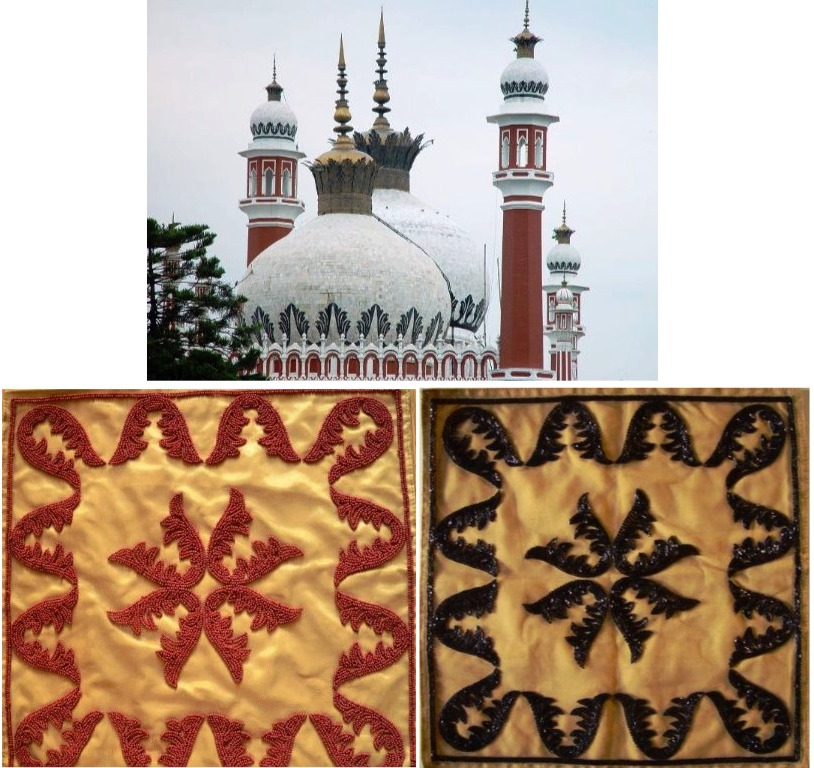
The acanthus leaf pattern on the dome of the Jama Masjid has been recreated on this cushion cover with zardozi embroidery using glass beads. The cushion covers were made using net fabric with satin lining and were embroidered in combinations of Brown and Maroon, Grey and White & Black & White; each piece taking 20-25 hours to complete.
Date :2019-06-13
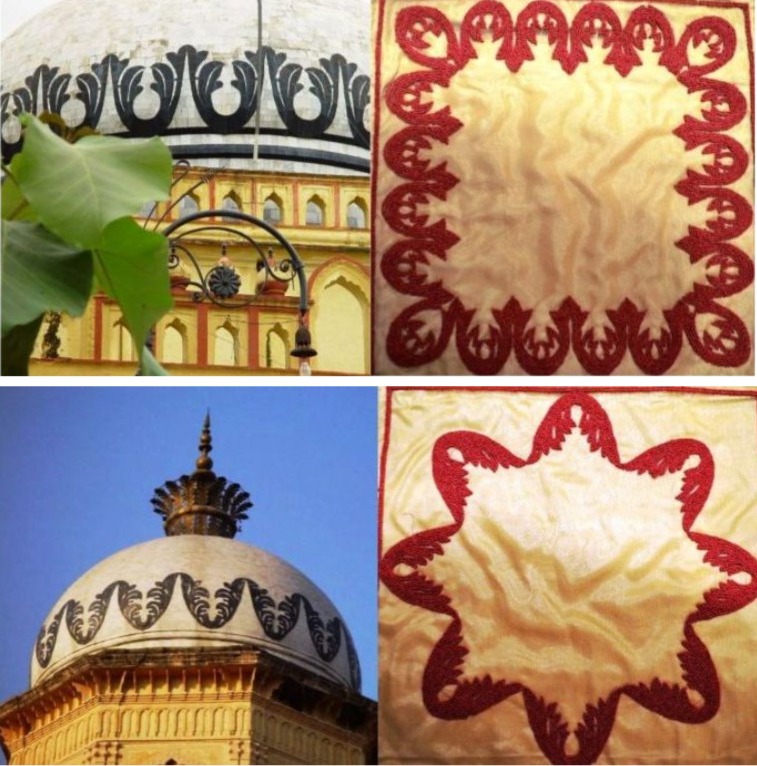
The acanthus leaf pattern on the dome of the Raza Library has been recreated on this pair of cushion covers with zardozi embroidery using glass beads. The cushion covers were made using net fabric with satin lining and were embroidered in combinations of Brown and Maroon, Grey and White & Black & White; each piece taking 10-15/20 hours to complete depending on the detail of the design.
Date :2019-06-13
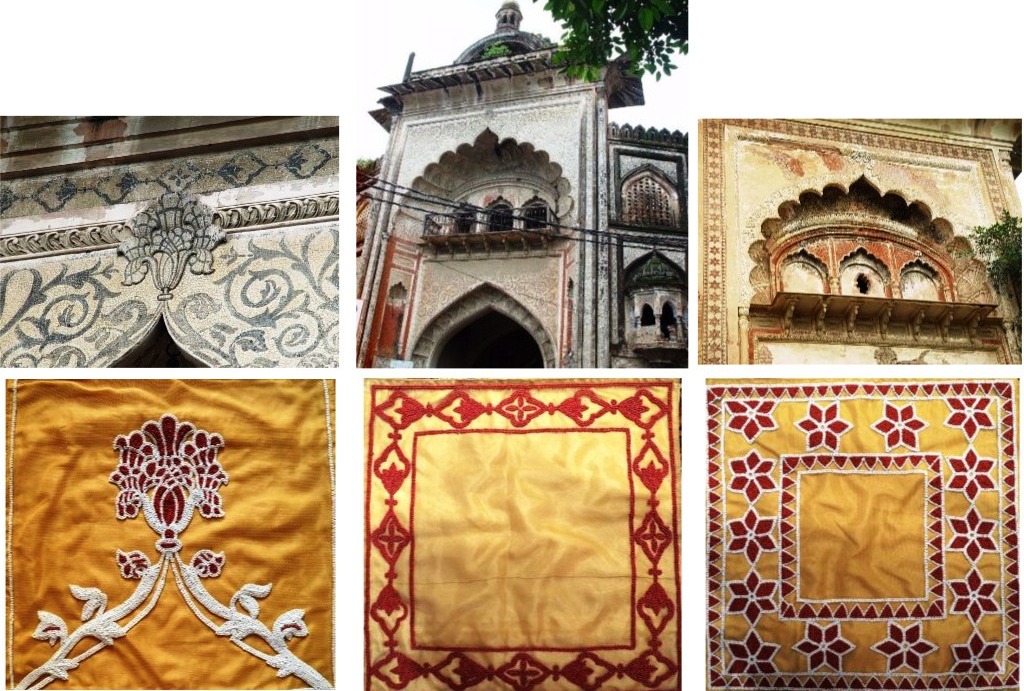
The most elaborately decorated gate of Rampur was the Wright Gatenamed after W.C. Wright, the Chief Engineer chosen for building the city. During the course of the Rohilla Mohalla Project, the Wright Gate was broken down as part of a “road widening / modernizing” drive and the photographs taken at the beginning of the project (2012) are amongst the last to be taken of the rich decorative designs on the gate.
The three cushion covers in this set are based on the designs of Wright gate, which have been recreated with zardozi embroidery using glass beads. The cushion covers were made using net fabric with satin lining and were embroidered in combinations of Brown and Maroon, Grey and White & Black & White; each piece taking approximately 15/20/25 hours to complete depending on the detail of the design.
Date :2019-06-13
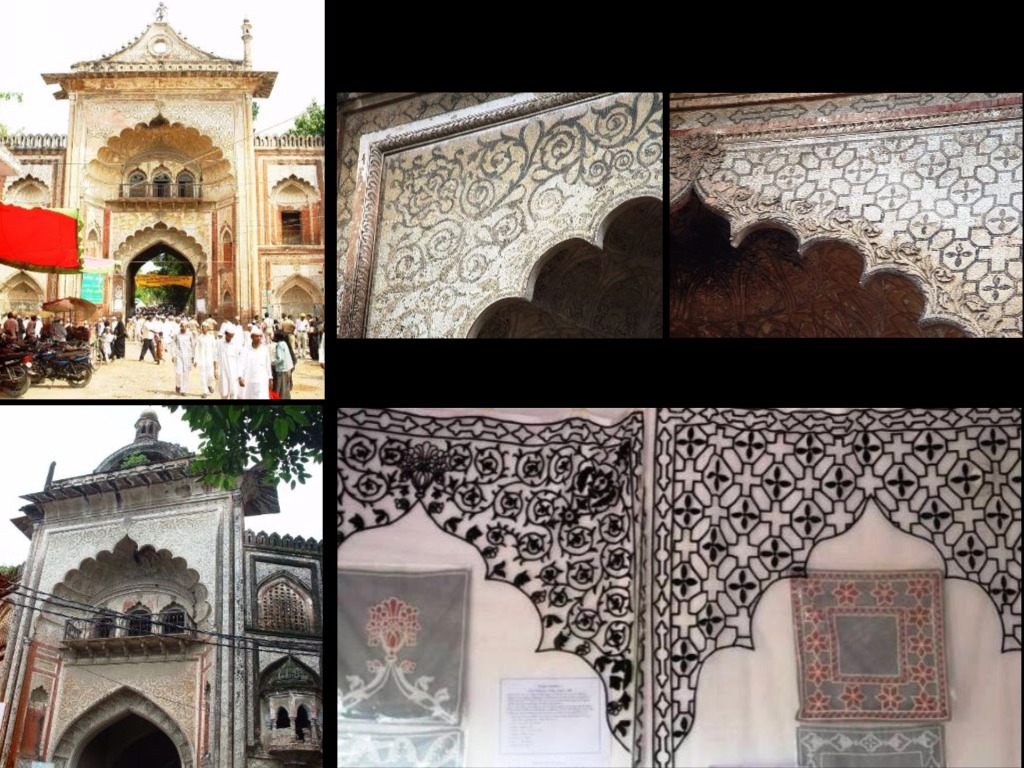
This pair of curtains in the mihrab design, are inspired by the floral patterns decorating the Wright Gate & the geometric pattern on the façade of the Hamid Gate. A uniform border brings them together as a pair. These sheer net curtains were made in combinations of Black & White and Brown & Maroon and are entirely hand crafted with zardozi embroidery using glass beads, each curtain taking 25-30 hours to complete.
Date :2019-06-13
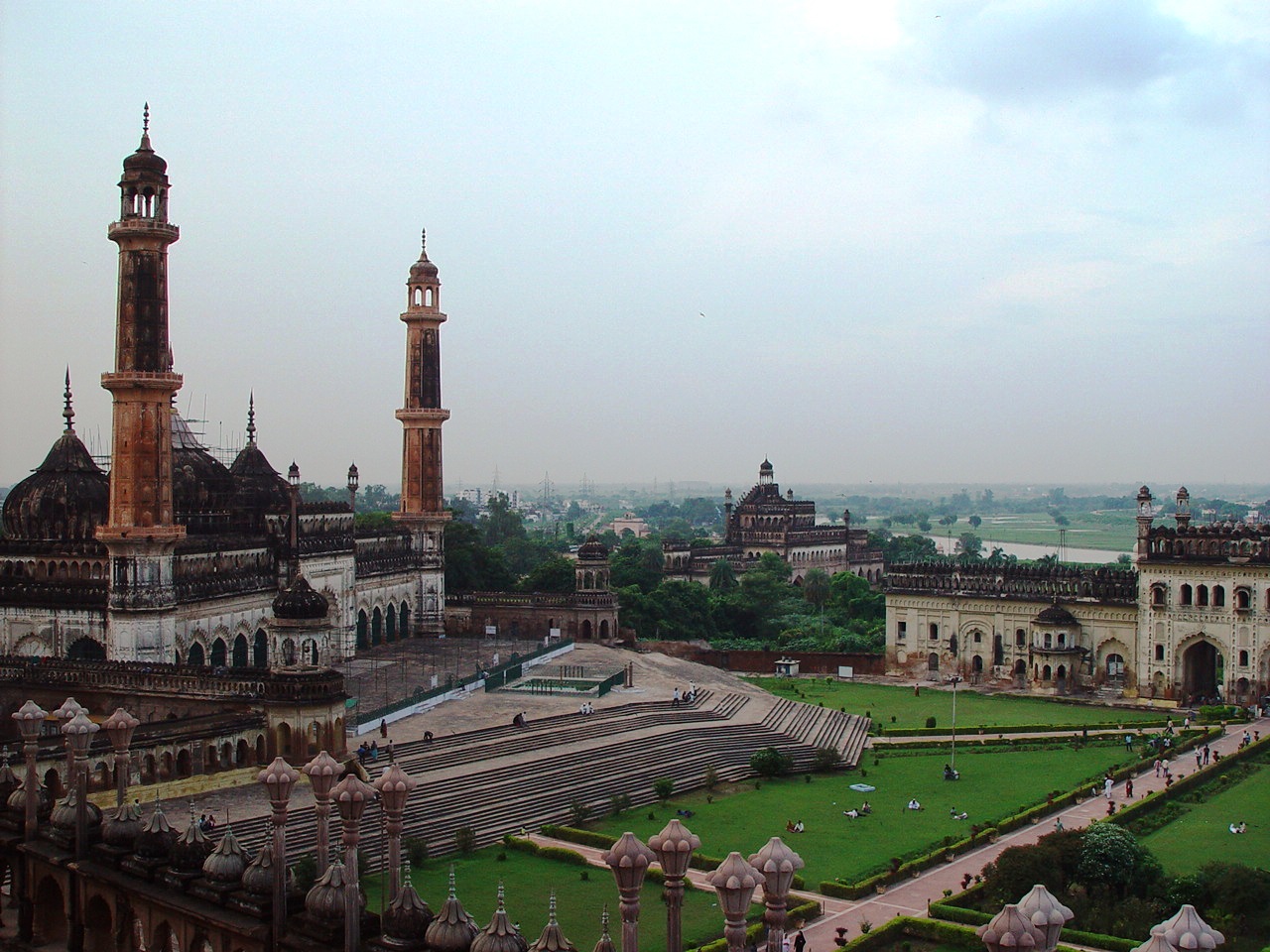
The Shia Nawabs of Lucknow constructed several grand palaces, Imambaras and gates including the Rumi, Kaiser Bagh & Hossainabad darwazas. The decorative floral, geometric and fish pattern designs on these structures are highlighted in this collection. The spirit of Nawabi Lucknow was perfectly captured in the film “Shatranj ke Khiladi”, and is represented in this collection as well.
Date :2019-06-13
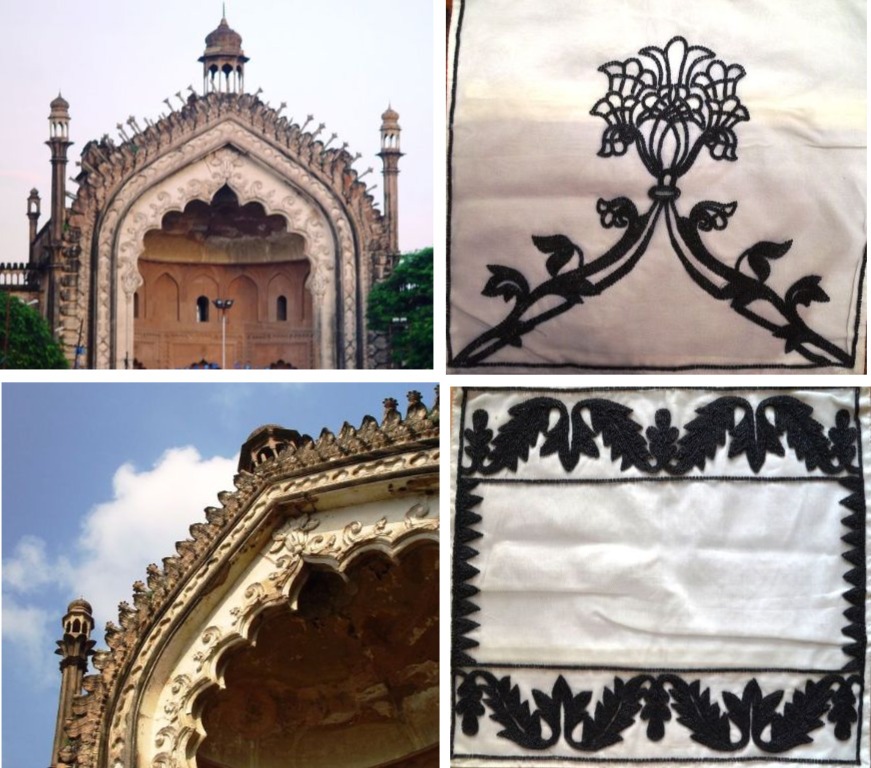
It was said that the famous Sufi poet Jelaluddin Rumi met Hazrat Shams al Tabriz, a wandering dervish for the first time in the mid 13th century below a gateway in the market place of Konya in Turkey in a meeting that had a profound impact on Rumi. The two developed a strong bond of friendship and the love and inspiration was expressed by Rumi extensively through his poetry. The Rumi Darwaza could perhaps have been built as a homage by the Shia Nawabs to this great Sufi poet to mark his meeting with his friend and spiritual guide Hazrat Shams al Tabriz at the gateway in Turkey.
This pair of cushion covers is inspired by the floral patterns on the Rumi Darwaza. The designs have been recreated with zardozi embroidery using glass beads. The cushion covers were made using net fabric with satin lining and were embroidered in combinations of Brown and Maroon, Grey and White & Black & White; each piece taking approximately 10-15 hours to complete.
Date :2019-06-13
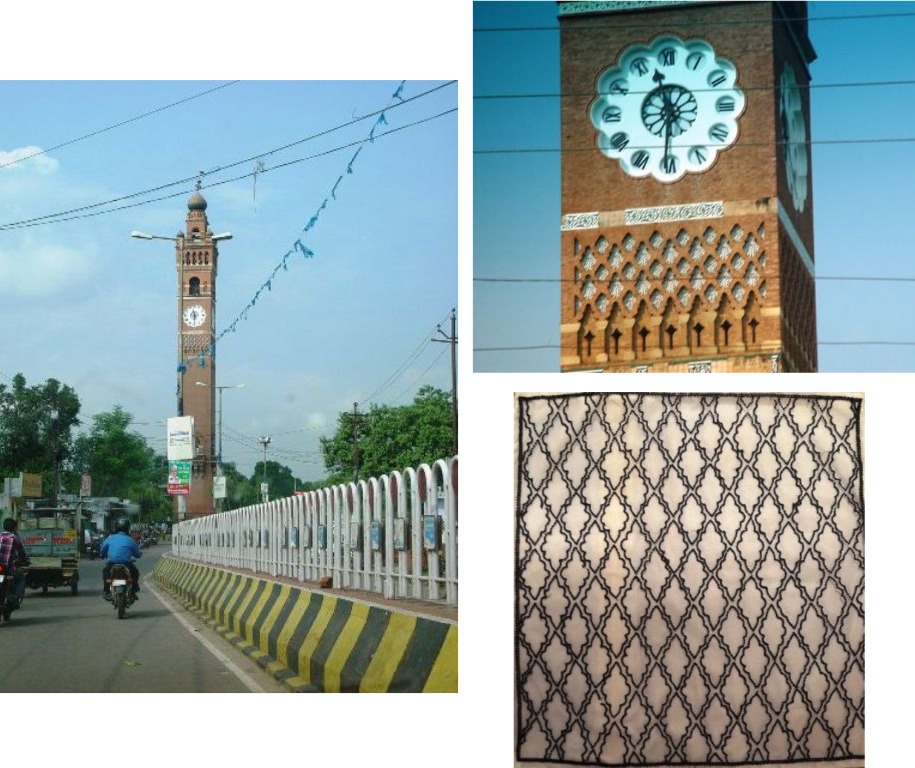
This Cushion Cover is inspired by the geometric pattern on the clock tower across the Rumi Darwaza. It has been embroidered using the zardozi technique on net fabric with satin lining, in combinations of Brown and Maroon, Grey and White & Black & White; each piece taking approximately 10-15 hours to complete.
Date :2019-06-13
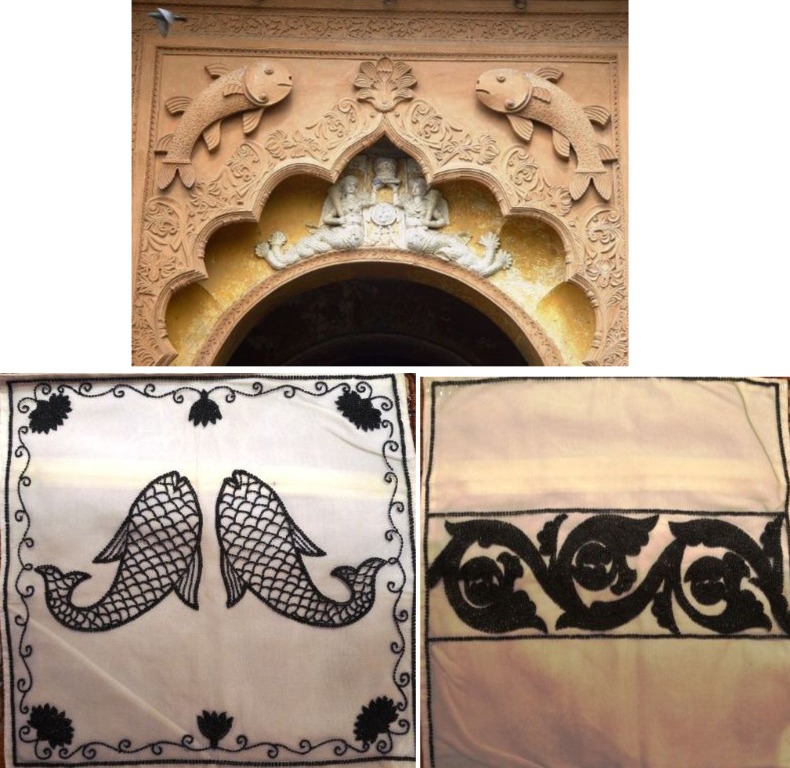
This pair of Cushion Covers is inspired by the fish and floral motifs on the Lakhi Gates at the entrance to Kaiser Bagh, built during the reign of Nawab Wajid Ali Shah.
The twin fish motif existed even in the Indus Valley iconography. In Awadh, it became part of the royal insignia and a dominant decorative symbol in architecture and crafts. It is said that after being appointed the Governor of Awadh, Nawab Saadat Khan Burhan-ul-Mulk.on his way to Lucknow from Farukkhabad, was crossing the river Ganga, and two fishes leaped into his lap. This was considered a good omen, coinciding with the beginning of the golden era of the history of Awadh.
The designs have been recreated with zardozi embroidery using glass beads. The cushion covers were made using net fabric with satin lining and were embroidered in combinations of Brown and Maroon, Grey and White & Black & White; each piece taking approximately 10-15 hours to complete.
Date :2019-06-13
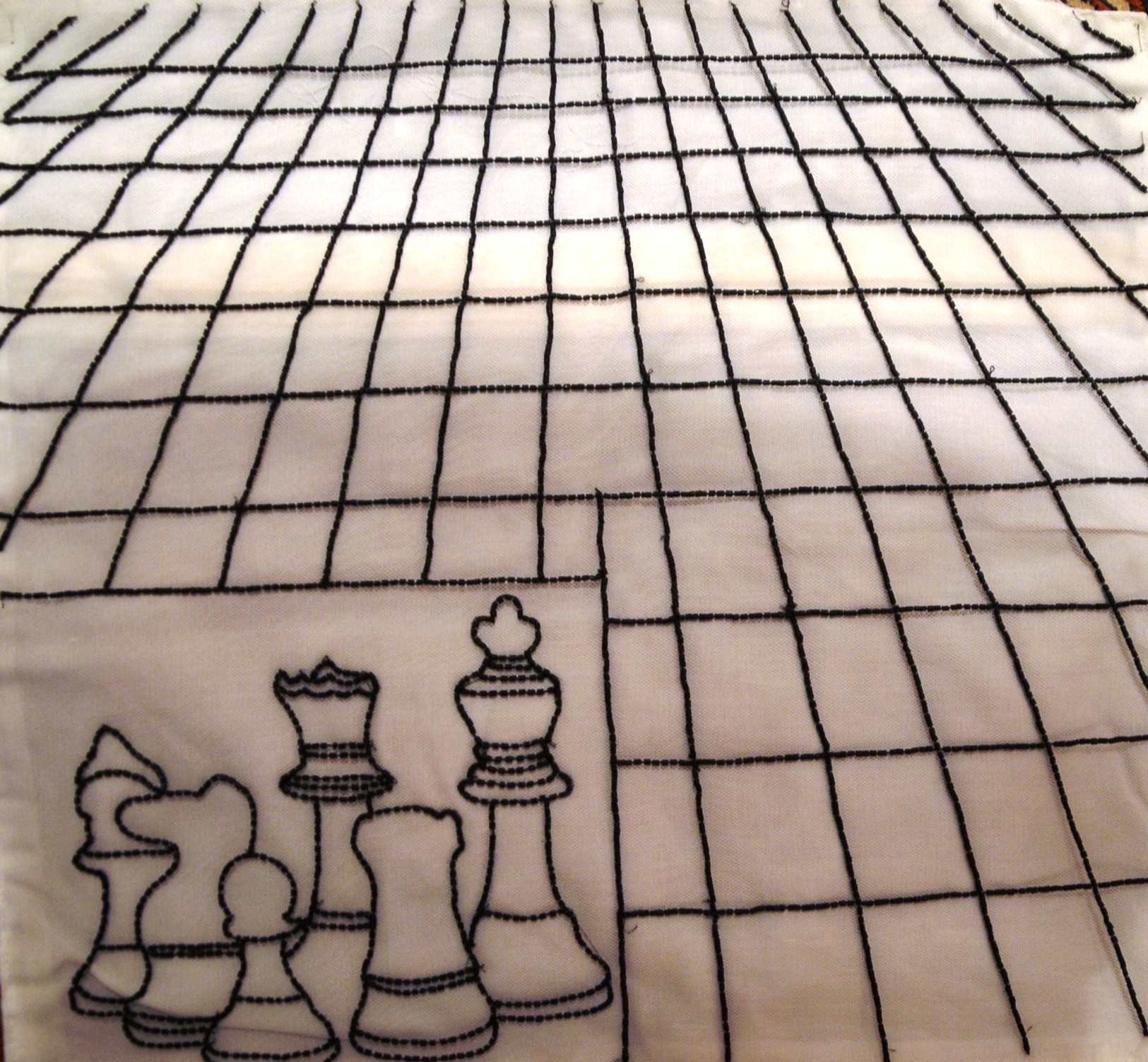
This cushion cover is inspired by Munshi Premchand’s hindi story by the same name written in 1924, which captured the essence of Lucknow’s culture under Nawab Wajid Ali Shah on the eve of the 1857 rebellion. The story was made into a film by Satyajit Ray in 1977. The cushion cover is made with zardozi embroidery using glass beads on net fabric with satin lining and was embroidered in combinations of Brown and Maroon, Grey and White & Black & White; each piece taking approximately 10-12 hours to complete.
Date :2019-06-13
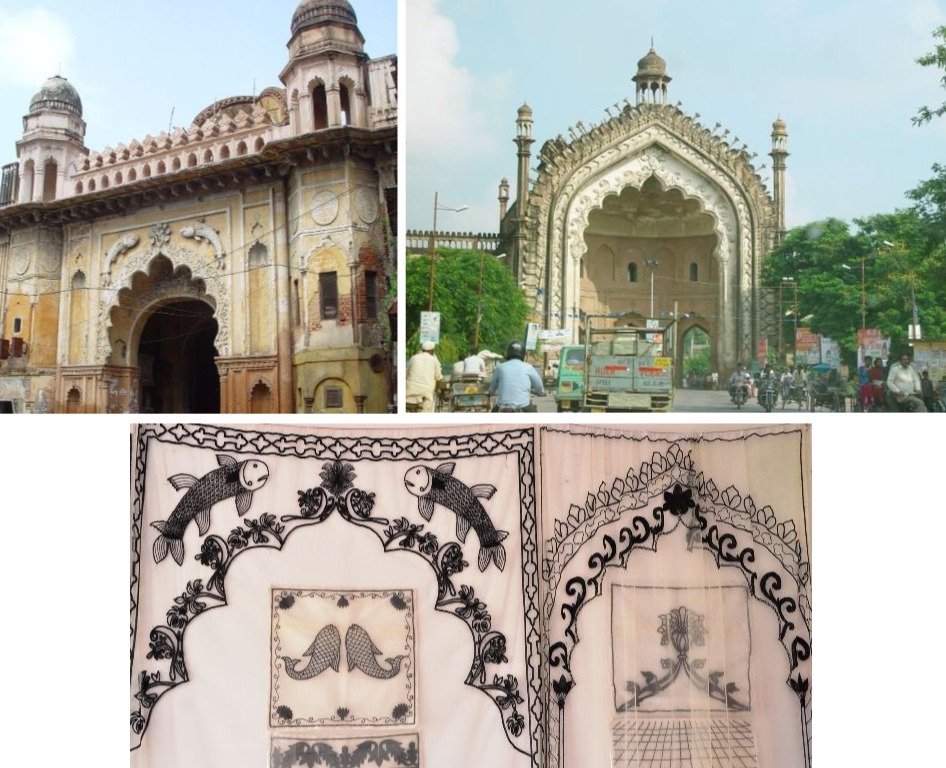
This pair of curtains in the mihrab design, are inspired by the floral patterns decorating the Rumi Gate & the fish pattern on the façade of the Lakhi Gate. A uniform border brings them together as a pair. These sheer net curtains were made in combinations of Black & White and Brown & Maroon and are entirely hand crafted with zardozi embroidery using glass beads, each curtain taking 25-30 hours to complete.